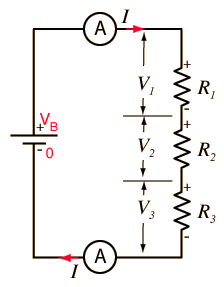DC Series Circuit
 |
For this series circuit, the voltage law dictates and the combination of resistors gives In applying Ohm's Law with the battery voltage, you must realize that the battery voltage is applied to the total circuit (all three resistors) and not to any one of them alone. So the entire resistance must be used in Ohm's law to get the current:  |
| DC circuit examples |
| HyperPhysics***** Electricity and Magnetism | R Nave |